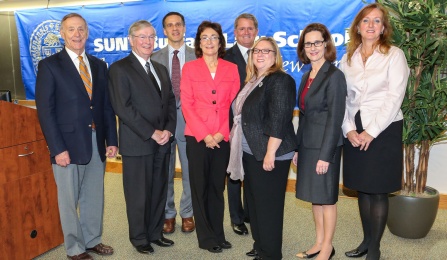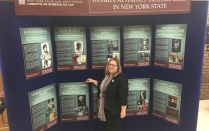Law Links - November 2015
Forum celebrates five pioneering women lawyers

Hon. ALbert M. Rosenblatt, Hon. Eugene F. Pigott Jr. ‘73, Interim Dean James B. Gardner, Hon. Paula L. Feroleto ‘82, Michael B. Powers, Lecturer Bernadette Gargano, Hon. Erin M. Peradotto ‘84, Michelle Henry
At a time when women labor side by side with men in law schools, law firms and courts, it’s easy to forget the challenges the earliest women lawyers faced.
In a forum at UB School of Law, they remembered.
Remembered when it wasn’t just a cultural assumption but settled law that a woman’s place was solely in the home. When it was thought no one would accept legal advice from a woman. Even when paternalistic do-gooders feared that the rigors of higher education would so sap a woman’s strength that she would be rendered infertile.
The Nov. 5 event, called “Western New York Women Pioneers in the Law,” drew students, faculty and members of the legal community. It was sponsored by the School of Law, the Historical Society of the New York Courts, and Phillips Lytle.
Following introductory remarks by interim Dean James A. Gardner, Hon. Eugene F. Pigott Jr. '73 of the New York State Court of Appeals, and Hon. Paula L. Feroleto '82 of the 8th Judicial District, the program – moderated by Hon. Albert M. Rosenblatt, president of the Historical Society of the New York Courts – focused on five high-achieving women with ties to Western New York.
Hon. Erin M. Peradotto '84 of the Appellate Division, 4th Department, delved deepest into the past in sketching the life of Belva B. Lockwood, the first woman admitted to practice before the U.S. Supreme Court. Born in Royalton, Niagara County, in 1830, Lockwood studied law at the National University School of Law in Washington, D.C. She did well, but the university refused to grant her the law degree – until Lockwood wrote to President Ulysses S. Grant, who intervened on her behalf.
In trying to take an appeal to the Supreme Court, Peradotto said, Lockwood was stymied by previous rulings that women were not allowed to practice before any federal court. She lobbied vigorously in Congress, and a bill was passed and signed into law overturning that prohibition. She was admitted to practice before the Supreme Court in 1879, and last argued before the high court in 1906, at age 75. She also ran – twice – for president on the National Equality Party line, at a time, Peradotto said, when “women could not vote, so she couldn’t even vote for herself, but her candidacy was an important symbolic victory for women.”
Chautauqua County historian Michelle Henry gave a brief biography of Kate Stoneman, the first woman admitted to practice in New York. A native of the town of Busti, Stoneman, born in 1841, “read and reread a large, musty old law book that her family owned,” Henry said. “It was one of the few books that they owned.”
As an adult she taught herself by reading law books, and even passed the bar exam, but was refused admission to the bar. Finally the state Legislature amended the Code of Civil Procedure in 1886 to allow women to practice law in New York State; Stoneman renewed her petition and was the first woman accepted.
Interestingly, Henry said, it was only then that Stoneman pursued formal legal education, at Albany Law School, graduating in 1898 at age 57. A woman of prodigious energies, she also threw herself into the temperance movement and the establishment of a world peace organization.
Lecturer Bernadette Gargano presented the next biography, of Helen Z.M. Rodgers, the first female graduate of the School of Law. From Staten Island, where her father ran a fancy hotel, Rodgers came to Buffalo for law school and never left.
It was a different time, Gargano said: Electric lighting was not yet widespread, people kept their perishable foods in iceboxes, and women wore corsets. Not only were women denied the vote, but married women who worked did not have the right to their own wages.
Before marrying, Rodgers made some binding agreements with her fiancé, including the right to be referred to by her own first name instead of Mrs. Elbert Rodgers, and the right to “full and complete liberty of action.” She and Cecil B. Wiener, the only other female law student, became fast friends and graduated from the Buffalo Law School in 1899. Rodgers continued to work and advocate until her death in 1960.
“In forging our own paths,” Gargano said, “I ask you to remember these women pioneers as people who cleared the path for us. They supported each other; they walked arm in arm to earn these rights. Today we can take solace in their courage as we continue to clear the path for women in our profession.”
Michael B. Powers, Clarence town justice and a Phillips Lytle partner, presented Charlotte Smallwood-Cook, the first female district attorney in New York, not only in words but in video. As part of an oral history project, he had interviewed her in 2011.
Smallwood-Cook, born in 1923, moved with her husband to Warsaw, in Wyoming County, after her graduation from Cornell Law School in 1946. She ended up with a 65-year career in law, telling Powers, “I just got too old to retire.”
It was in 1949, after she had practiced for just a couple of years, that she ran for DA against great resistance from many quarters. The county’s Republican establishment offered little support; the Democratic opposition tried to paint her as someone who would turn Wyoming into a dry county. To beat back that challenge, she told Powers, she walked in the door of every bar in the county, ordered a drink and had a chat with the bartender. “Word got around,” Powers said. “They would say, ‘She’s not against alcohol; she’s been in here, she was in here the other day.’ ” She won with 65 percent of the vote.
Finally, Rep. Brian Higgins sketched out a life of Shirley St. Hill Chisholm, the first African-American woman elected to the U.S. Congress. Chisholm represented New York’s 12th District from 1969 to 1983.
Higgins said Chisholm got involved in Democratic politics at the grassroots level as an early childhood educator in New York City. She saw that the women were doing all the grunt work while the men got the glory, and set about changing that. She went to Albany as a newly elected member of the Assembly in 1964, and, he said, “was not greeted with open arms. But she parked herself in the Assembly library in the Capitol and immersed herself in skills of governing.”
Chisholm ran for Congress in 1968, with harsh words for the party machinery that denied opportunities to women and minorities. Higgins said she didn’t think much of Congress, either, finding inertia, laziness and self-interest rampant. She protested her first committee assignment, to the Forestry Committee, and instead was assigned to the Veterans Committee, which she accepted because, she said, “I have more veterans in my district than I have trees.”
She also, Higgins said, ran for president in 1972, and found an unlikely friend in George Wallace, the segregationist Alabama governor, even praying with him in his hospital room after he was shot.
“She never thought she could win,” Higgins said of that presidential bid. “But that’s the rarest form of leadership: somebody who commits themselves to a cause that they won’t live to see. She paved the way for not only a woman to run for president, but for an African-American to run.”
